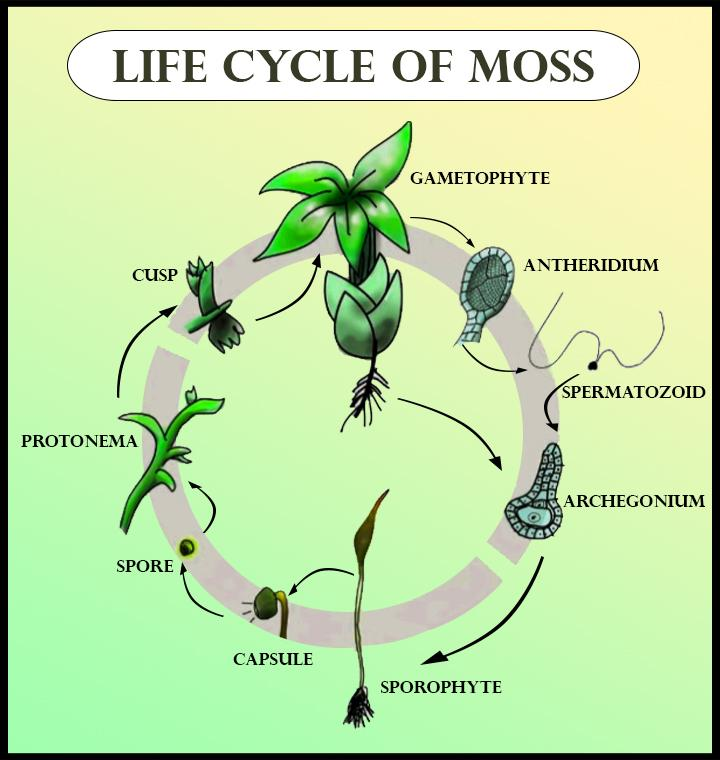Answer
401.7k+ views
Hint: They belong to the amphibians of the plant kingdoms and also show the alternation of generation in their life cycle.
Complete answer:
Mosses belong to the division Bryophyta. They are the small, non-vascular plants that are flowerless. They are autotrophic as they undergo photosynthesis. The life cycle of mosses shows alternation of generation. They consist of only a single set of haploid chromosomes. The period when the moss plant has two paired chromosomes is known as the sporophyte stage.
The life cycle starts with the sore, which is haploid and resulting in the production of protonema. Protonema is the thallus-like, flat thread-like filaments. From this stage, gametophore grows, which later forms stems and leaves. The gametophore is the gamete bearers.
From the tips of the gametophore stems, the sex organs are developed. The female organs are known as archegonia (small, flask-shaped cells with an open neck, and male organs are known as antheridia (sperm). In the water, sperm swim towards archegonia, and fertilization occurs. The pollination occurs mainly through the wind.
After fertilization, the immature sporophyte pushed out of the archegonial venter and developed into the mature sporophyte. They consisted of seta (long stalk), and a capsule capped cell called an operculum. In the capsule during meiosis, spore formation occurs and forms haploid spores. After this, the new cycle begins.

Note: Mosses were generally grouped with the hornworts and liverworts. The fossil fuel of moss is studied that they recovered from early Permian later in the Carboniferous and Silurian period. They evolved only about two to three times much slower than ferns, gymnosperms, and angiosperms.
Complete answer:
Mosses belong to the division Bryophyta. They are the small, non-vascular plants that are flowerless. They are autotrophic as they undergo photosynthesis. The life cycle of mosses shows alternation of generation. They consist of only a single set of haploid chromosomes. The period when the moss plant has two paired chromosomes is known as the sporophyte stage.
The life cycle starts with the sore, which is haploid and resulting in the production of protonema. Protonema is the thallus-like, flat thread-like filaments. From this stage, gametophore grows, which later forms stems and leaves. The gametophore is the gamete bearers.
From the tips of the gametophore stems, the sex organs are developed. The female organs are known as archegonia (small, flask-shaped cells with an open neck, and male organs are known as antheridia (sperm). In the water, sperm swim towards archegonia, and fertilization occurs. The pollination occurs mainly through the wind.
After fertilization, the immature sporophyte pushed out of the archegonial venter and developed into the mature sporophyte. They consisted of seta (long stalk), and a capsule capped cell called an operculum. In the capsule during meiosis, spore formation occurs and forms haploid spores. After this, the new cycle begins.

Note: Mosses were generally grouped with the hornworts and liverworts. The fossil fuel of moss is studied that they recovered from early Permian later in the Carboniferous and Silurian period. They evolved only about two to three times much slower than ferns, gymnosperms, and angiosperms.
Recently Updated Pages
How do you arrange NH4 + BF3 H2O C2H2 in increasing class 11 chemistry CBSE

Is H mCT and q mCT the same thing If so which is more class 11 chemistry CBSE

What are the possible quantum number for the last outermost class 11 chemistry CBSE

Is C2 paramagnetic or diamagnetic class 11 chemistry CBSE

What happens when entropy reaches maximum class 11 chemistry JEE_Main

Calculate the volume occupied by 88 gram of CO2 at class 11 chemistry CBSE

Trending doubts
Difference Between Plant Cell and Animal Cell

Difference between Prokaryotic cell and Eukaryotic class 11 biology CBSE

Fill the blanks with the suitable prepositions 1 The class 9 english CBSE

Fill the blanks with proper collective nouns 1 A of class 10 english CBSE

Change the following sentences into negative and interrogative class 10 english CBSE

Give 10 examples for herbs , shrubs , climbers , creepers

Name 10 Living and Non living things class 9 biology CBSE

What organs are located on the left side of your body class 11 biology CBSE

Who gave the slogan Inquillab Zindabad A Bhagat Singh class 10 social science CBSE



